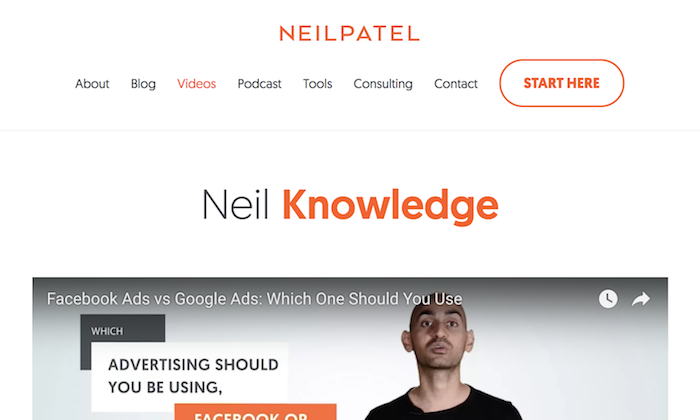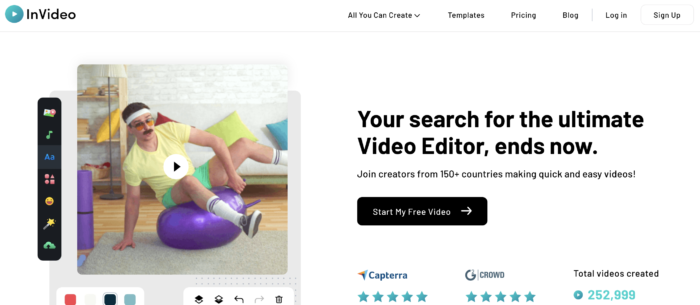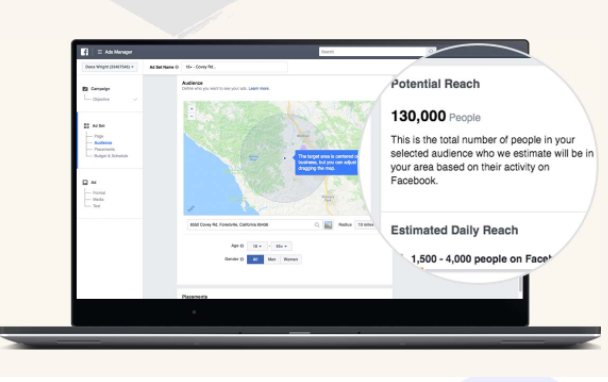So, you want to get involved in video marketing.
I don’t blame you. It’s where more and more attention is heading these days.
Just take a look at these stats that HubSpot published on the state of video marketing this year.
That’s right, 500 million people on Facebook watch videos every day, and 10 billion watch them on Snapchat!
And it’s no surprise why. Video content is some of the easiest to consume.
There’s just one slight issue.
When you don’t know what you’re doing, it can also be one of the hardest types of content to create.
But if you want your marketing campaign to be successful, you’ll want as much attention as possible.
And having a video content component to your marketing campaign is a guaranteed way to ensure that you’re maximizing your outreach potential.
In fact, you might even see some of your videos go viral if you play your cards right.
So, you’re ready to take your first steps into this brave new world.
If you’re completely unfamiliar with video marketing, you’re bound to make quite a few mistakes along the way.
That’s why I decided to put this guide together. I’ve pinpointed the 7 most crucial components of any successful video marketing campaign.
The sooner you master these, the sooner you’ll be on your way to dominating the digital media landscape with your amazing video content.
Feel free to hop around the list below if you see anything that you’re worried about specifically.
Once you’ve done that, I recommend you come back and read the entire article from the beginning.
Even if you think you’ve got everything else handled, I’m sure that my breakdown will present you with some fresh insights.
- Make a plan (and track it)
- Go with what you know
- Start creating
- Search matters
- Team up with influencers
- Use ads to their full potential
Okay, enough small talk. Let’s get started!
1. Make a plan (and track it)
Before you dive into the world of video marketing, it’s important that you start with a plan.
I know, this section looks like the forced section of every guide-style article where you’re told that you need to create a plan before you continue.
But honestly? That’s actually pretty good advice!
The way I see it, any consistently effective marketing campaign is defined by consistent growth.
And how the heck are you supposed to measure growth if you’re not tracking your progress?
That’s right, it’s not enough to just write down your goals. You need to hold yourself accountable.
Did you achieve those goals? Fantastic! But can you tell me why your video content worked?
If it didn’t work, do you know why it flopped?
For reference, take a look at the Smart Insights SMART goals.
If that’s too intense, here’s a condensed cheat-sheet version for when you’re creating goals for your brand or business in the marketing world.
- Is this goal specific? General goals like “get more subscribers” or “increase traffic” don’t give you much insight in the long run.
- Is this goal achievable? There’s nothing wrong with being ambitious, but expecting to get 1 million subscribers on YouTube in your first 6 months might be a bit much.
- Is this goal trackable? The sweet spot of goal-setting is a realistic goal that you can track. Whether you achieve it or not, you’ll end up with valuable data by the end.
If you started creating video content today, and six months from now, you had no definitive idea on the future direction of your content, I’d argue that your campaign was in serious trouble.
Achieving consistent growth with video content comes down to two things:
- Finding what works and recreating it in future videos, and
- Finding what doesn’t work and making sure that it’s not in your future videos.
Those are the basics of consistently increasing the effectiveness of your video content.
Everything that you do as it relates to creation needs to be serving one of those two purposes, one way or another.
As it relates to promoting your videos and ensuring that you’re maximizing your outreach potential, having a strategy in place can make a world of difference.
Let’s say you’ve just made a great piece of video content. You could just let it sit on your website and hope that people will find their way to it.
But I wouldn’t hold my breath.
Like any form of marketing, being proactive is mandatory.
Post your video on Facebook, Instagram, Twitter, Pinterest…anywhere that you can.
Especially if you’re working with a modest marketing budget (or no budget at all) like I talk about in the video below.
You’re doing this for two reasons.
As far as short-term goals go, this is going to ensure that you have the biggest possible audience.
People who follow you on Instagram may not follow you on Facebook, and vice versa.
Assuming you don’t have completely overlapping audiences, if you want to be sure that you’re reaching every one of your followers, you’ll want to post on all your social media accounts.
In the long term, posting to all your social media accounts will give you a better idea of where your video is performing best.
It might seem like a minor detail, but this small piece of data can influence where you choose to invest more time and energy promoting your videos. (But more on that later.)
2. Go with what you know
Speaking of video creation, there’s one major question you need to answer before you actually start creating anything.
What style of content should you be making in the first place?
There are three widely-accepted forms of content in the marketing community.
Educational Videos
These are the types of videos that are built around either actionable steps that your audience can follow today or thought leadership that your audience can incorporate into their lives tomorrow.
I often make educational videos, such as this one:
Inspirational Videos
In inspirational videos, you capture breathtaking views, reveal awe-inspiring moments, or produce motivational content designed to fire people up.
Last summer, Jay Alvarrez made waves with his video documenting his travels.
Entertaining Videos
In this category, you’re trying to get people to laugh or smile. The content should intrigue them to investigate your brand further.
Just a month ago, YouTube channel Dude Perfect came out with a trick-shot video that has already been seen 31 million times!
But which type of video should you make?
Honestly, this is an easy enough question to answer if you’ve already started making other types of content.
If you’ve been creating educational content for your audience on your blog, your best bet would be to start with educational video content and see if that resonates with them.
If your podcast is something super casual, like the Joe Rogan Podcast, don’t start by putting together an educational video. Go for entertaining content and see if your audience likes the new format.
When you’re not sure where to begin, go with what you know.
As time goes on, you’ll develop a stronger understanding of what type of video content works and what doesn’t.
You’ll have plenty of information, not just through the metrics you’re tracking, but also from the feedback that you’re getting from your audience in the comments.
Trust me, if they want a different type of video, they’ll ask for it.
Pay attention to your comments section! I certainly do.
You should feel free to experiment with styles of content, of course. But if you’re completely at a loss, don’t try to reinvent the wheel.
3. Start creating
Okay, now that we’ve gotten all the planning out of the way, it’s time to dive into the fun part.
Creation might seem a bit intimidating at first, especially if you’re completely new to the world of video, but I’ll let you in on a little secret.
Your first video is supposed to be your worst.
Think about it! If every video is an improvement on the last one, it only makes sense that your first video is your worst, right?
Instead of stressing out over every minor detail, dive into the creative process.
You’ve already made a plan. You have an idea for your first video.
Instead of trying to figure out the perfect way to start your video content creation journey, just get that first video out of the way.
Trust me, it’s only going to get easier.
Don’t get me wrong. You should still try to provide as much value as you can and be as professional as possible.
But expecting this video to be perfect is just unrealistic.
In the world of written content, you provide value by doing everything from offering tangible advice to being a great storyteller.
As far as I’m concerned, the sooner you start actually making relevant content, the better.
Creation means you’ll get feedback. And getting feedback means the quality of your content will improve.
It really is that simple.
Don’t have any of those fancy filming tools yet? No problem. I’ve got just the thing.
Go ahead and reach into your pockets for me. Feel that rectangular piece of metal in there?
If you’ve got a smartphone, you’ve got what it takes to make a video.
It might not be perfect, but that’s absolutely okay.
As your video marketing strategy develops over time, you can upgrade and invest more time and money into video creation.
You can use InVideo as your one-stop solution to video editing and customization. The best part? You don’t need to have a ton of experience with design or editing to make awesome videos.
And why stop there? You can hire professionals to put together your videos, buy professional camera equipment yourself, and so much more.
Take a look at the jump in quality of videos from people like Gary Vaynerchuk.
Here he is at the beginning of his YouTube career.
And here he is years later, with a massive bump in production value.
But before you start worrying about how you’re going to do all that, you have to start with the basics.
There is no perfect time to start. So start right now.
4. Search matters
I love discussing the creative process and useful tricks to use in the world of video marketing.
But there’s more to executing a successful video marketing strategy than what you can see on the surface.
Behind the scenes, SEO is still massively important, whether you’re a fan of it or not.
It’s so important that I made a video for local businesses on how to pull it off without a huge marketing budget.
Let me be clear. If your video content is not being optimized for search, you are almost certainly missing out on free exposure.
Scary, right? Don’t worry. I’ve got a quick fix to get you back on track.
If you’re familiar with SEO for your blog, this is all going to seem oddly familiar.
The same way your article title should have keywords that you’re looking to rank highly for, your video title is going to determine your ranking on sites like YouTube.
Even if you’re familiar with SEO through your blog, this next part will probably be news for you.
That description section that’s available for your videos? That’s taken into consideration for search, too.
The general idea here is still the same. Avoid keyword stuffing. Make sure your keywords are actually relevant.
Typically, the best descriptions are those that accurately explain your video in conjunction with keywords.
Balance storytelling and metrics. It’s the cornerstone of truly effective marketing, and it’s especially important when it comes to video marketing.
5. Team up with influencers
It wasn’t too long ago that the ‘celebrity endorsement’ was something that only the world’s biggest brands could actually afford.
Smaller brands and local business could only sit back and watch athletes and actors use their mass appeal to help these businesses sell more of their products.
But things have changed.
With the explosion of the Internet and social media, the modern consumer has changed and so has the marketing landscape.
Make no mistake: Celebrity endorsements are still absolutely happening.
But as an alternative to the big-budget celebrity, smaller brands have taken to the Internet and found ‘micro-celebrities’.
These micro-celebrities are typically online influencers who have their own loyal following and a unique understanding of how to appeal to the people in their industry.
And frankly? They can be pretty darn effective.
The best influencers are able to run with your vision for content and provide you with unique and valuable insight on what kind of content to create.
Plus, there’s no denying that having your brand presented to a group of anywhere from 100,000 to several million dedicated followers can be massively impactful.
Just take a look at how Dude Perfect partnered with Hasbro to promote the company’s new Nerf product, the Mega Magnus.
Effectively teaming up with influencers comes down to two things.
- Choose your influencers wisely! If your brand is family-friendly, don’t reach out to someone who’s known for being controversial.
- Communicate! Don’t assume that you and the influencer are on the same page. It’ll inevitably lead to miscommunication, and you may end up with content you didn’t want.
6. Use ads to their full potential (walk people through this)
Just because you’re trying something new in the form of video content, that’s no reason to forget the principles of marketing that you’ve used with the rest of your content.
If you’ve been implementing a well-rounded marketing strategy, you should be drawing from both organic and paid traffic.
If you’re completely new to this, or you just want a refresher on how to maximize your ads, this part is for you.
Let’s take a look at the Facebook ads targeting mechanics.
Using Facebook ads, brands can easily tailor their ads to suit a variety of different users.
Your ads can target users based on their age, gender, location, interest, and much more.
With Facebook ads, you’ll even know what your typical daily reach is.
And the best part?
You can customize each individual ad to maximize its relevancy.
For example, let’s say that you created two videos.
The first video is for people getting ready to retire, and the second video is for people who just graduated college.
Instead of presenting your entire audience with an ad that likely won’t be very useful for them, you can ensure that each video gets its own category and is presented to relevant parties.
But don’t take my word for it.
When you increase the quality of your audience and ensure those ads are targeted, you’ll inevitably convert more users into customers.
Of course, Facebook isn’t the only place where you could choose to invest in ads.
Which brings up an important question. Where should you be spending your money on ads?
Well, remember all the way back in the first section, when I mentioned that posting in a variety of different places would help you in the long-term?
This is where that seemingly minor detail comes in handy.
Now that you’ve collected enough information on which platforms work best for your video marketing content, it’s time to put that data to use.
Armed with those metrics, you’ll be able to identify where your content is getting the most attention.
From there, it’s as easy as investing more in paid ads on those platforms.
If your audience likes to consume your videos on Instagram, Instagram ads it is.
If they love Facebook, promote on Facebook.
If you’re getting the most exposure out of YouTube, invest in YouTube ads.
Ride the wave of momentum, capitalize on your minor victories, and sooner or later, your video marketing content will take off.
Conclusion
For the record, I’m not going to sit tell you that video marketing is easy.
Creating compelling content can be an uphill battle sometimes, particularly when you’re first getting started.
But I can’t stress this enough: Your first video isn’t going to amazing.
And that’s totally okay!
Leave perfection to the artists. Out here in the marketing world, I’ll settle for meaningful progress.
Come up with a strategy. Execute that strategy by creating content as soon as you can. Take advantage of the platforms and resources at your disposal.
Video marketing may not be an easy way to build your brand, but once you get the hang of it, you’ll wonder why you waited this long to get started.
If you’ve already experimented with video marketing, what’s working for you? How have your paid ads on sites like Facebook and Instagram worked out?









Comments (24)